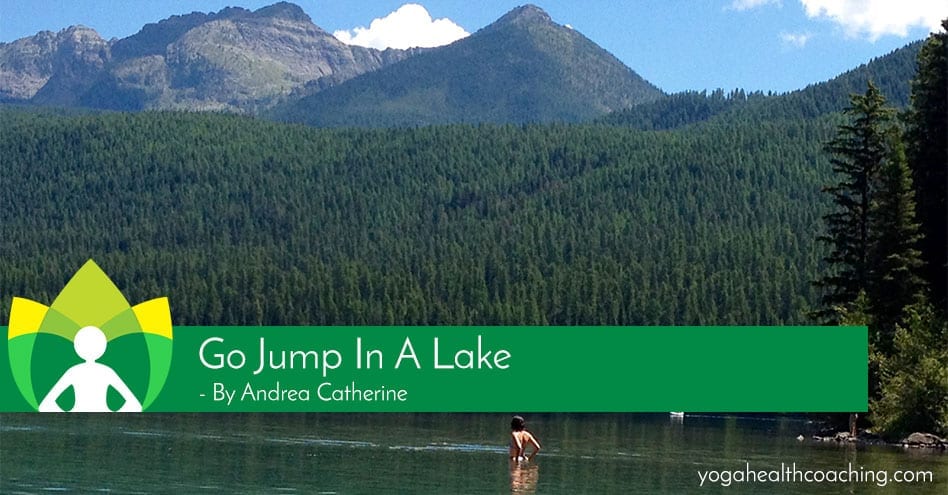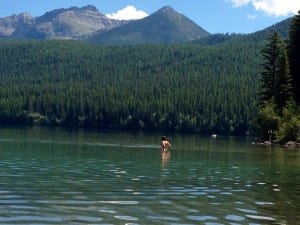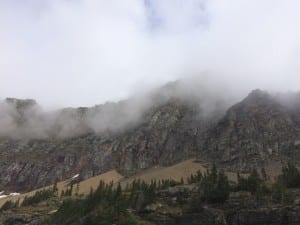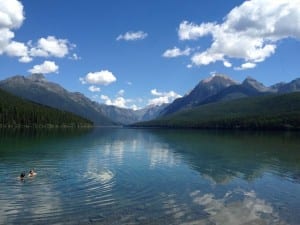
Go Jump In A Lake
Here it comes again, that drawing up of my lower jaw to my top teeth, my tongue muscling its way about my mouth to prove I am still strong, while my heart sinks. On days like this, when I feel less than who I know I am, less than I felt a moment ago, less than I perceive the other person I am blaming for how I now feel, I go jump in a lake.
Habits of daily self-care stacked perfectly one on top of the other like an untouched Jenga game begin to wobble with just the right move in the wrong direction. In fear of toppling over into a wallowing pity-party of self-sabotage, I go jump in a lake. The cool glacial swim that brings my head up to invite in mountain air quickly, is just what I need to get out of my head.
I open my eyes and see the beauty around me and gratitude begins to abundantly seep from every pore in my body into the water around me. I can’t help but smile and thank the guidance within me to muster up all my courage and throw myself in the water.
This works so well, in fact, that one week this summer, I swam in a different lake every weeknight. OK, so Friday night I swam in a different part of Tuesday’s lake, but you get the point. What I realized was that rehearsing this practice of intentionally confronting my resistance caught on. For the rest of the summer, I knew I could count on it.
 Water may be my first love and one of my best healers, yet, when life is anything but easy, my gut preference is to be under my covers or eating a bowl of ice cream. Ease, then, does not come from giving into my temptation, but from tapping into the discipline, the tapas, of balancing my bland perspective with something that will wake me up.
Water may be my first love and one of my best healers, yet, when life is anything but easy, my gut preference is to be under my covers or eating a bowl of ice cream. Ease, then, does not come from giving into my temptation, but from tapping into the discipline, the tapas, of balancing my bland perspective with something that will wake me up.
What’s your jump in a lake?
As the season cools, and snow-covered mountains are in view, stepping out into the invigorating fall air, slowly and intentionally, is sometimes enough.
To simultaneously wake up and ground myself in the present, I may also drive down a road without cell service embanked by rocky ranges, steep, and the potential of a bear lurking around a bend.

My most recent wake up of sorts, was not something I planned. After wandering past a group of hikers who spotted a mom and cubs on the trail ahead, I sat down on a rock about 100 yards beyond them, seeking some quiet. Soon enough, someone whistled. I stood up, and over my shoulder saw mom and babe bears headed my way. This heart-palpating encounter elicited the instinct to flee. I tripped immediately. My phone fell. The whistler hollered, “Don’t run!” Embarrassed and startled, I walked back to the group, glancing over my shoulder to see mom digging vigorously for grubs while baby stood by. I was safe. After expressing gratitude to the group watching my back, literally, I journeyed toward my car. This was a rare moment of the proper use of my sympathetic nervous system pumping up my adrenaline and informing me to move, NOW.
Sometimes, life itself throws us in a lake– or on on a path with some bears– if we aren’t keen to jump in on our own. Can you recall a moment when you were shocked by your own instinct and pulled instantaneously out of your so-called treasure trove of negative thoughts, reminded of the value of life, your life, in a way that woke you up to gratitude, and the freedom of not dwelling on blame or shame or the proverbial ho-hum?
No, I don’t think that jumping in a lake is a solution for escaping feeling painful emotions. There is so much value in feeling what’s up for us, I do believe, but that’s a future blog post. What I want to express is that there’s a time when I need a cold lake or or a bear on my trail. It’s when self-sabotage tells me there’s something I need to solve in order to feel better, and my heart rate is unnecessarily high (yet, there is no bear on my path), and my inhale seems to get stuck in my chest. I need to wake me up in order to reinstate my capacity for connection, presence and ease.
It’s the action to wake myself up that ultimately helps me to calm down, to return me appropriately to how Angela Wilson, in her article Yogic Breathing: The Psychology of Pranayama, describes our way of being when the Parasympathetic Nervous system is in control:
“more reflective, conscious behavior and action; an increased feeling of calm; and greater mental flexibility and creativity amid life’s challenges.”
This is preferable to the quickening inhales and exhales, and a racing mind that convinces me I better fight, freeze or flee. Even with bears hot on my trail, a warning not to run invited me to slow my breathing, making my present moment more easeful.
Take a moment to think of something that is not always easy to get yourself to do, but when you do, you always feel a little more alive. Perhaps it’s calling a mentor or loved one who champions you. Perhaps it’s getting down on the living room floor to let your ever-loving pup tumble with you and lick your face. Perhaps it’s putting on your gear for an invigorating run, or taking a gentle walk in the woods, or a long drive, unplugged from technology.
 If you’re feeling stuck, give yourself a moment to breathe into that. Notice if wallowing or self-judgement arise. What is it like to let them be there for a moment? What happens when you name what you’re feeling? When you say, hello pity and “I’m not enough,” I see you. Slide your attention then to your breath, then to the sounds around you. Notice all you can about this moment both within and without yourself. Be in this observation a few moments before shifting back to your task at hand. It may be that after a little introspection, you’ve mustered the courage to jump in the lake.
If you’re feeling stuck, give yourself a moment to breathe into that. Notice if wallowing or self-judgement arise. What is it like to let them be there for a moment? What happens when you name what you’re feeling? When you say, hello pity and “I’m not enough,” I see you. Slide your attention then to your breath, then to the sounds around you. Notice all you can about this moment both within and without yourself. Be in this observation a few moments before shifting back to your task at hand. It may be that after a little introspection, you’ve mustered the courage to jump in the lake.
For support in knowing you are enough, and that this moment can be easeful, too, check out the Body Thrive Program. If you’re ready to take baby steps, you might start with an app, like Chill-Let Go and opt in for push notifications that bring you back to the now & your enough-ness every day. When all else fails, soften your jaw and lips, shake your head from side to side and make a silly noise.
[dt_button link=”https://yogahealthcoaching.com/wp-content/uploads/2016/10/Movie-on-9-15-16-at-9.14-AM-1.mov” target_blank=”false” button_alignment=”default” animation=”fadeIn” size=”medium” style=”default” bg_color_style=”default” bg_hover_color_style=”default” text_color_style=”default” text_hover_color_style=”default” icon=”fa fa-chevron-circle-right” icon_align=”left”]Download[/dt_button]
Do it now, start today. In fact, as Cate Stillman so boldly suggests in her book, Body Thrive, “Today = New Day,” there’s no need to wait for tomorrow (Stillman, 247).


